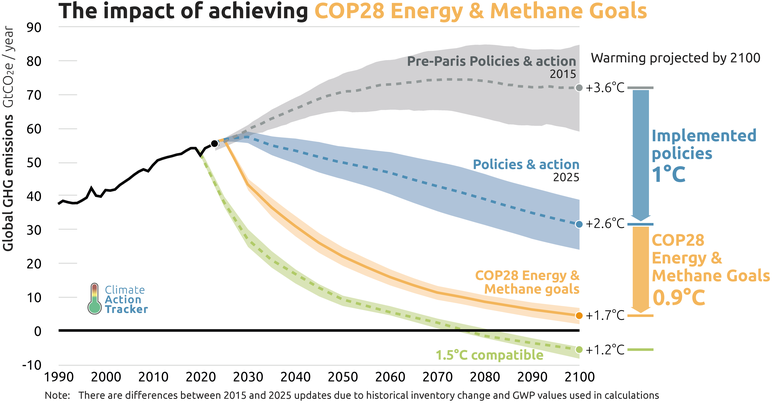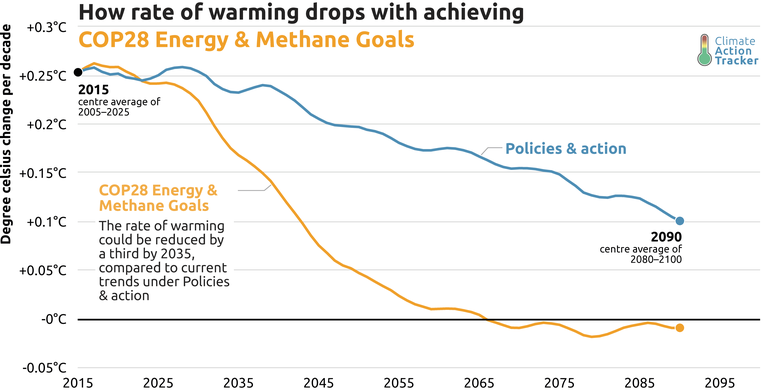Three key near-term actions could bend the warming curve; bringing projected warming below 2˚C
Attachments
Summary
Key findings
- Tripling renewables, doubling energy efficiency and cutting methane by 2030 and beyond would cut warming rate by a third in ten years, and halve it by 2040.
- It would cut projected warming this century significantly (about 0.9˚C from 2.6˚C to 1.7˚C).
- Scaled up financial support to achieve this will be needed for many poorer countries.
- Rapidly reducing the rate of warming is critical for adaptation.
At COP 28 in Dubai, 2023, as part of the first Global Stocktake (GST1) discussion, the world’s governments negotiated and agreed a clear set of 2030 energy and methane goals that aligned with limiting warming to 1.5°C. These included tripling renewable energy capacity, doubling the rate of energy efficiency improvements, and cutting methane emissions.
We show for the first time the huge climate benefits if governments were to implement what they have negotiated and agreed for these three critical energy and methane goals. We evaluate the global benefits of governments taking concerted action to deliver on the goals by 2030 and 2035, both in terms of emission trajectories and warming implications.
These actions would bring projected 21st century warming below 2°C. The outlook improves significantly (by about 0.9°C), almost as much as the entire 1°C improvement in the global warming outlook seen over the ten years since the Paris Agreement was adopted in 2015, and would be a major step towards keeping the 1.5° limit in sight.
Unlike any previous improvements in targets and policies under the Paris Agreement, the implementation of these measures would quickly begin to slow the rate of warming from about 0.25° per decade at present, rather than under current policies which would see a slight acceleration by 2030.
Halving the rate of warming in the near term would give communities a realistic chance to cope with rising climate impacts, and, with adequate international climate finance, begin to “catch up” and close the adaptation gap.
This analysis underscores a clear imperative: the accelerated expansion of renewable energy, expansion of electrification and the associated phase-out of fossil fuels are indispensable to achieving the Paris goal. Delivering on these agreed targets would not only narrow the emissions gap but also lay the foundation for a resilient, low-carbon global economy. The action agenda of the COP30 Presidency represents a key space to mobilise commitment in the delivery of these goals.
If the G20 were to implement the three goals...
When looking at the impact of individual G20 countries implementing the COP 28 goals for renewable energy, energy efficiency and methane, we find that they would deliver total emissions reductions of around 11 GtCO₂e by 2030 and 14 GtCO₂e by 2035, compared to current policy projections.
- Tripling renewable energy within the G20 would account for roughly 40 % of total emissions reductions. Expanding renewables is the backbone of the energy transition as it delivers dual benefits: displacing fossil fuels directly and powering electrification across sectors, which in turn drives greater energy efficiency.
- Doubling energy efficiency would contribute another 40% of the G20’s total reductions, almost half of which through the electrification of energy end use sectors.
- Methane mitigation would deliver a further 20%, providing rapid, near-term benefits. These percentages would be roughly the same for the extrapolation at the global level.
Country analysis
Our assessment of the emissions impact of achieving the three energy and methane goals agreed at COP28 builds on a country level analysis of the G20, where the EU is treated as one geography. The briefing document includes country factsheets that provide results for each of the G20 geographies.
Each of the three COP28 Energy and Methane goals, Tripling Renewables, Doubling Energy Efficiency and Reducing Methane, follow slightly different implementation paths in each country, depending on the country’s starting position and ability to drive rapid change. Key indicators are presented for each goal for both, 2030 and 2035, showing the policy outcomes each country needs to aim for, to contribute to the global goal.
The emissions graph at the top presents total GHG emissions (excl. LULUCF) for the target year of the country’s latest NDC (2030 or 2035). It shows the full emissions reductions achievable if the indicators for each goal are reached by that country, in comparison with the expected emissions level under current policies for that year. For comparison, the following are also shown:
- The emissions level the country has committed to achieving in their (conditional) NDC and
- The emissions level that would align with a 1.5°C compatible pathway.
Find out more
Click the button below to read the full briefing document including the country factsheets.
Stay informed
Subscribe to our newsletter

